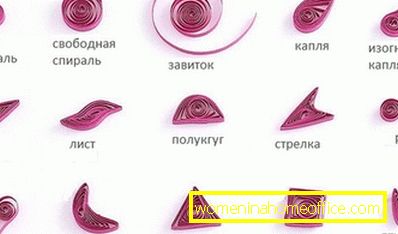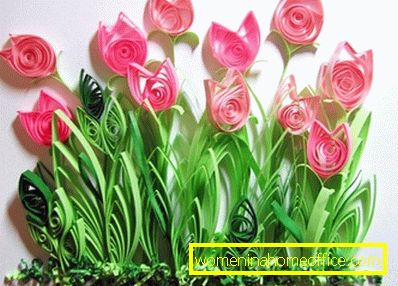Quilling crafts
Quilling is becoming more and more popular today - the art of twisting paper and forming certain elements out of it has chances to bypass the classical origami soon. Quilling crafts can even be folded by children, although, undoubtedly, developed skills are needed to implement complex ideas. But the basic things in any category - from the design of postcards to jewelry - can be built without any preparation.
Quilling: lessons for children and beginners

As already explained, quilling is a special technology for twisting small paper elements, which later become components of a large figure. And before staring at serious crafts like flowers or animals, you need to work out the moment of twisting the basic parts. The main one is a simple curl or “roll”: if it is tight, then it is just a strip of paper rolled up in a snail, the tip of which is necessarily glued - this is true for any element. If the "roll" is free, there is a small distance between each of its turns, so that it can be slightly deformed. There is also an open "roll" when its end is not fixed by glue, and this is the only such case. From 2 open "rolls" can get a "heart", if they are connected by the inner sides, or "horns", if diluted outside. The latter often become the antennae of a butterfly when creating crafts using the quilling technique.
It is most convenient to twist each element not with your fingers, but with the help of a toothpick: its end is split and the tip of the paper strip is inserted into it, after which its entire length begins to be wrapped around the split portion. If you squeeze free “roll” from 2 sides, you will receive a new element - “eye”. If you squeeze it only from the 1st side, slightly pulling it back, a “drop” will be formed, which can also be deformed by slightly bending a crescent. In fact, all the basic elements are modifications of the usual free "roll" with varying degrees of weakening of its curls and various kinds of deformations: stretching, bending, flattening. When these parts are obtained without errors, they can be glued together to each other into simplest figures: from drops "and" horns "to make a butterfly, from a tight" roll "and" leaves "flower.
Quilling: flower and compositions with his participation


After the basic elements have been studied, it is necessary to try to add more complete compositions from them than simple chains that do not have a special form and idea. The most versatile and affordable here is considered to be a flower, ideal for decorating planes - from a postcard to a mirror frame or a photo. And if you collect a few flowers, their stems can be "planted" in a pot-bellied vase, which is laid out from simple taut rolls. Or simply fasten on a thin strip with twisted pieces of paper imitating blades of grass. The main thing - to keep the form and idea.
For example, delightful large flowers on 5 petals are laid out from free spirals, weakened in one direction. Their center shifts to the opposite side, as a result of which the shape of the circle changes to a drop. The heart of the flowers are dense rolls of the same color or traditionally yellow. And so that the flowers were not loners, and the whole composition turned out, the leaves, impaled on long rods, are laid out from the “drop” element. The highlight of the resulting picture can be a butterfly, formed from "drops", "leaves" and free "rolls".
Flowers in the technique of quilling can be not only planar, but also voluminous. For example, a Japanese ornamental tree is made up of precisely such small flowers, gathered in a large ball. If you take a closer look, you can see that the buds are made of loose “rolls”, randomly deformed, and wrapped in thin sheets of green paper imitating an external hardwood calyx. With the help of the same quilling, but already tight "rolls", a flower tree trunk was created: the rolls werehers were simply stacked on top of each other by a pyramid and fixed with glue. The only thing that for the construction of such a tree will need a light small ball, which will be the frame: it is on him that the "flowers" will be glued.
Crafts from quillingas the air, twisted pattern account already attracts attention and leaves no room for indifference, and if the finished product is blocked with acrylic paints, creating a soft transition between colors, you will be able to achieve a truly fantastic effect. And additional processing with varnish will add volume and durability to the craft.